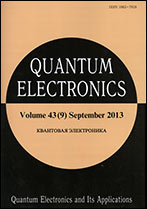|
Brief Communications
Heated-cathode pulse CO2 laser pumped by a gas discharge at atmospheric pressure
V. N. Karnyushin, A. V. Malov, R. I. Soloukhin
Abstract:
An investigation was made of the distribution of the gas density in a discharge gap of a continuous-flow CO2 laser with a heated cathode. The influence of the cathode heating on the laser threshold was determined. It was established that the use of a heated cathode made it possible to increase the molecular gas content in the working mixture by improving the homogeneity of the discharge.
Received: 23.02.1975
Citation:
V. N. Karnyushin, A. V. Malov, R. I. Soloukhin, “Heated-cathode pulse CO2 laser pumped by a gas discharge at atmospheric pressure”, Kvantovaya Elektronika, 2:8 (1975), 1822–1824 [Sov J Quantum Electron, 5:8 (1975), 994–995]
Linking options:
https://www.mathnet.ru/eng/qe15648 https://www.mathnet.ru/eng/qe/v2/i8/p1822
|


| Statistics & downloads: |
| Abstract page: | 147 | | Full-text PDF : | 75 |
|





 Contact us:
Contact us: Terms of Use
Terms of Use
 Registration to the website
Registration to the website Logotypes
Logotypes








